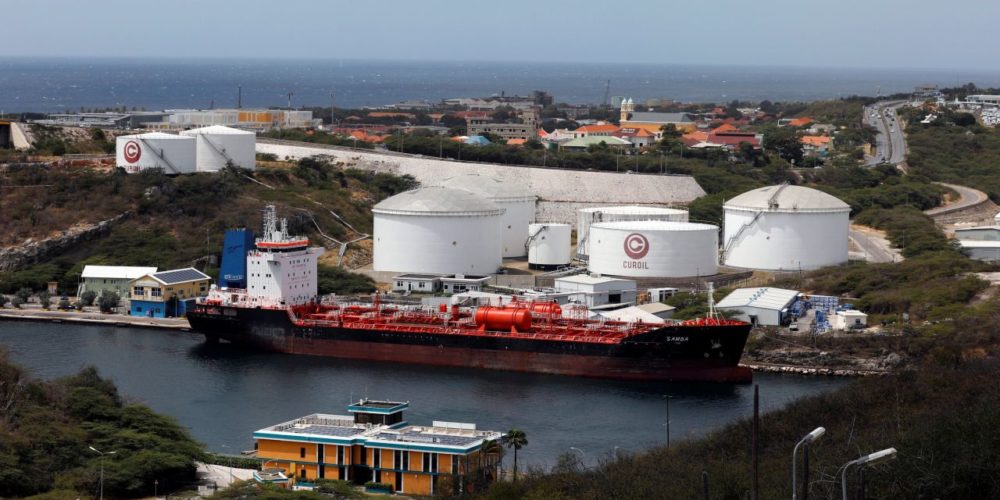From Telesur
The United States has been playing the role of the world’s economic bully. So far it has imposed sanctions against Afghanistan, Belarus, Burma, Burundi, Central African Republic, China, Democratic Republic of Congo, Crimea, Cuba, Cyprus, Eritrea, Haïti, Iran, Iraq, North Korea, Lebanon, Libya, Russia, Somalia, Sudan, South Sudan, Syria, Ukraine, Venezuela, Yemen, and Zimbabwe.
But if unilateral harassment has proved ineffective in achieving conventional geopolitical objectives, why does the United States insist on bullying Venezuela and Iran?
A glance at the political economy of international oil markets—an industry used as a battlefield for furthering the aims of war—provides an insight into the seemingly irrational realm towards which Donald Trump has been leading US foreign policy.
Energy-independence requires manipulating markets
As international markets are highly speculative, many people believe that price trends cannot be manipulated; but that is not true. When energy commodities and strategic raw materials are involved, the United States does not sit back as a patient price-taker but prefers to throw the dice as a price-maker.
Between 2006 and 2014, when China’s economic boom was increasing the demand for international commodities, structural changes occurred that, ironically, favoured the United States a few years later.
Firstly, high oil prices allowed the fracking industry to become a financially viable option. This in turn helped the United States to gradually overcome the dependence it had experienced for thirty years and that made it the world’s largest oil importer in 2016, with a voracious appetite of about 12 million barrels per day.
In December 2018, for the first time in seventy-five years, the United States became a net oil exporter, thanks to “thousands of wells producing from the Permian region of Texas and New Mexico to Bakken in North Dakota and Marcellus in Pennsylvania,” according to a report in the Los Angeles Times. In the words of Michael Lynch, president of Strategic Energy and Economic Research Inc., “We are becoming the dominant power in the world.”
Trump is reaping the fruit of energy-independence, a condition he did not contribute to at all.
This abundance of energy is fragile, however, because maintaining it depends on keeping oil prices as high as possible. To force this to happen, therefore, anything that threatens to diminish global oil supplies is actually good for the United States, including the blockade of Venezuelan and Iranian exports.
And that’s not all . . .
While the United States now has enough oil to be able to export some of its reserves, Trump’s homeland can’t satisfy the world’s energy demands completely. This opens up business opportunities for Saudi Arabia and other allies, which can also benefit from economic sanctions against Venezuela and Iran.
Before April 2018, when the United States began applying a new round of sanctions, Iran was OPEC’s second-largest producer, exporting almost 3 million barrels per day. Since then, however, its oil production has been reduced by more than 1 million barrels.
In Venezuela, US foreign policy has achieved a similar result: between February 2018 and January 2019 Venezuela’s average oil output dropped from 1.5 million barrels per day to 1.1 million, not much more than half its production in 2006.
These combined results have triggered a trend towards the contraction of global oil supplies, which could be worsened if the Libyan civil war adds another cut of 1.2 million barrels per day in the near future.
Nevertheless, the oil market’s invisible hand is not enough to ensure those high prices the United States desperately needs, as global supply essentially meets global demand, moving about 99½ million barrels per day, according to the International Energy Agency.
This won’t change on its own: global economic growth will not easily lead to a new boom in demand for oil. On the contrary, factors such as Brexit and the US trade war against China could reduce growth prospects all over the world.
In this context, where the demand for oil remains more or less fixed, putting Venezuela and Iran out of business changes the share of the pie each country gets. And, of course, only the lucky ones get to continue enjoying their slice of the oil markets. Among these is Saudi Arabia, a country that will be able to capture more clients and expand its oil output without violating its OPEC commitments.
Oil prices have already responded to America’s politically motivated supply shortages. The average spot price for crude oil rose from $56 per barrel in January to $67 per barrel in May, an increase of 16 per cent. This would not have been possible without the sanctions that prevented Venezuela from selling more than half its production in February.
The international average oil price will most probably remain below $100 per barrel, but today’s unstable equilibrium prices are enough to keep American companies in the fossil-fuel business, at home and abroad.
One of the short-term costs of this manoeuvre could be price volatility. However, it seems that the Trump government has assimilated such an eventuality; global stability hasn’t ever been one of America’s foreign policy priorities.
Looking at it pragmatically, the negative consequences of harassing Venezuela and Iran are outweighed by a very lucrative reward: 2 million barrels of oil per day. As Reuters commented on 5 May, the United States now removes about 2 million barrels per day from the world’s supply, through sanctions on the Iranian and Venezuelan oil industries. But it hopes that soaring American oil production—now at a record 12 million barrels per day—will keep global markets well supplied, and hold prices down.
The political manipulation of supply and demand is a risky rent-seeking game. And this is where Trump’s personality could play an important role. He is not a risk-averse player; and so far he seems unconcerned with the collateral damage arising from his economic warfare. One of these is that sanctions “will help oil producers because the prices will go up, and Russia will be one of the most significant oil producers,” according to Robert Malley, former Middle East adviser to Barack Obama, as reported by the Novosti press agency.
We are no longer living in that “good old world” in which US geopolitics were for ensuring the flow of cheap natural resources from the closest friendly provider. Hence, ironically, a regional production crisis near US territory could be good for the United States in the medium term, as Giancarlo Elia Valori wrote in Geostrategic, adding that “the US is entirely in favour of an increase in the oil barrel price—and hence indirectly in favour of tension in Venezuela.”
Trump opens war fronts everywhere, which wouldn’t seem to make sense unless they were a distraction. But they’re not.
The rise of China as a global power has been silently transforming the international monetary system, another element triggering the United States into endless economic bullying.
Since the abandonment of the gold standard in 1971, the US dollar is not linked to any assets, becoming a fiat currency. In such cases only a country’s output could back the currency in the long run. But what happens when monetary expansion occurs faster than increases in productivity?
Bringing new meaning to the motto “In God we trust,” coined so long ago, the dollar’s value depends on its capacity to remain an international reserve currency—that is, a currency that other countries hold as part of their foreign-exchange reserves and use in their international transactions.
In a world where economic agents don’t ask the Federal Reserve to convert their notes into gold, or any other physical asset, trust is the only thing keeping the United States upright. As a result, the dollar has remained a mighty currency, because most international transactions are traded in US dollars.
On 30 January, in fact, the US national security adviser, John Bolton, revealed very little when he blatantly admitted that the attempted coup in Venezuela was really about grasping for oil resources. But in reality, aggression by the United States hides something much more than that.
If the dollar stops being the world’s most traded currency, the United States will not be able to issue the notes it needs to finance an almost fifty-year government deficit, which rose from $666 billion in 2017 to $779 billion in 2018.
The US budget deficit is how much more the government spends than it receives in revenue annually. The deficit in the US budget for the fiscal year 2020 is expected to be $1.1 trillion. This is the biggest deficit since 2012. Trump has ramped up the deficit to pay for record levels of military spending.
The dollar losing status as the world’s preferred currency would give the United States problems in paying for imports in an economy where its lack of international competitiveness has produced a trade deficit since 1976, which widened to $50 billion in March.
Last but not least, if the dollar stops being almighty the United States will have a very difficult time maintaining itself as a world-class economy, as its government debt exceeded $22 trillion in February. This is more than 76 per cent of what the country is able to produce in one year. Nevertheless, this is most likely to get worse: the debt-to-GDP ratio will rise to 150 per cent by 2049, according to the Congressional Budget Office.
Besides preventing Venezuela and Iran from exporting their natural resources, the United States is actively seeking to avoid the collapse of the dollar, an inevitability in the next few years, as the history of previous empires has shown. This is why the Trump government is prone to fighting against the use of barter, virtual currencies, or other alternative international payment methods.
Sanctions are not whimsical expressions of this president: they are tools used to retain hegemonic power in a multipolar world no longer willing to tolerate such an aspiration. At the core of US bullying is not ideological disagreement but economic decline.






